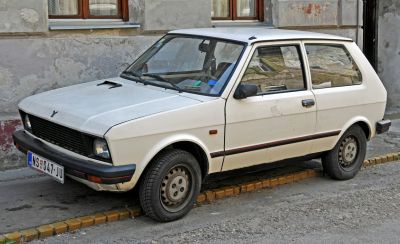 1974 Audi 50 (Typ 86) Dimensions, Size & Specs
1974 Audi 50 (Typ 86) Dimensions, Size & SpecsMeasurements of the 1974 Audi 50, engineered for optimal performance and comfort
| Dimensions | |
|---|---|
| Length: | 3490-3538 mm137.4-139.3 in11.5-11.6 ft |
| Width: | 1560 mm61.4 in5.1 ft |
| Height: | 1344 mm52.9 in4.4 ft |
| Trunk Capacity: | 260 liter9.2 cu ft |
| Trunk Capacity (Max): | 660 liter23.3 cu ft |
| Weight Specifications | |
| Curb Weight: | 685 kg1510 lbs |
| Maximal permitted Weight: | 1100 kg2425 lbs |
The Audi 50 (Typ 86), produced between 1974 and 1978, is a compact hatchback that marked Audi's entry into the small car segment. With a length ranging from 3490 mm to 3538 mm (137.4 to 139.4 inches), a width of 1560 mm (61.4 inches), and a height of 1344 mm (52.9 inches), the Audi 50 presents a compact footprint ideal for urban driving and maneuverability. It weighs a lightweight curb weight of approximately 685 kg (1,510 lbs), with a maximum permissible weight of 1100 kg (2,425 lbs), enabling efficient performance and fuel economy. The hatchback offers a practical luggage capacity of 260 liters (9.2 cubic feet) with the rear seats upright, which expands impressively to 660 liters (23.3 cubic feet) when the rear seats are folded down. This capacity flexibility makes it versatile for carrying everyday items or larger cargo. The Audi 50's compact size, lightweight construction, and adaptable storage make it a noteworthy example of a 1970s European hatchback, combining practicality with energetic handling. This generation laid foundational aspects for future small Audi models, highlighting efficiency and smart space utilization.
Discover the standout features that make the 1974 Audi 50 a leader in its class
Have a question? Please check our knowledgebase first.
The Audi 50 (Typ 86), produced from 1974 to 1978, has a length ranging between 3490 mm to 3538 mm (approximately 137.4 to 139.3 inches). This slight variation depends on specific model configurations and trim levels. Its compact length fits well within the subcompact category, making it suitable for urban driving and easy maneuverability.
The width of the Audi 50 (Typ 86) is 1560 mm (61.4 inches). This relatively narrow width compared to modern vehicles contributes to the car's agility and ease of navigation through tight city streets and parking spaces. However, the narrower width also means a more compact interior cabin, affecting shoulder room and potentially passenger comfort, but typical for its era and class.
The Audi 50 (Typ 86) stands at a height of 1344 mm (52.9 inches). This height provides decent headroom for front and rear passengers relative to the car’s compact size. The lower height contributes to a sporty and aerodynamic profile, enhancing visibility for the driver and contributing to stable handling dynamics at moderate speeds.
The curb weight of the Audi 50 (Typ 86) is 685 kg (approximately 1,509 lbs), and its maximum weight is 1100 kg (about 2,425 lbs). The lightweight design promotes nimble handling and better fuel efficiency, which was a distinct advantage during the 1970s when this model was produced. The relatively low maximum weight also reflects the car's compact size and modest passenger and cargo capacity.
The Audi 50 (Typ 86) offers a luggage capacity of 260 liters (9.2 cubic feet) when the rear seats are upright, suitable for small bags or groceries. When the rear seats are folded down, the cargo space significantly increases to 660 liters (23.3 cubic feet). This flexible storage space allows owners to carry larger items, making the car practical despite its small overall size.
Yes, the Audi 50 (Typ 86) comfortably fits into a standard residential garage. With a length of up to 3538 mm (139.3 inches), a width of 1560 mm (61.4 inches), and a height of 1344 mm (52.9 inches), it is well within the size limits of typical single-car garages designed to accommodate vehicles up to approximately 6 meters (about 20 feet) in length and 2.5 meters (about 8.2 feet) in width. Its compact size makes parking easy and hassle-free in most home and urban environments.
The Audi 50 (Typ 86) is closely related to the early Volkswagen Polo models, as both cars share many design and engineering features. However, the Audi 50 is slightly more compact and lighter, with a length ranging from 3490 mm to 3538 mm (137.4 to 139.3 inches) compared to early Polo lengths around 3,500 mm. The Audi 50’s smaller dimensions and lighter curb weight of 685 kg (1,509 lbs) versus the Polo’s varying weights provided a more agile driving experience, emphasizing economy and city use. Both cars occupy the supermini segment, but the Audi 50 offered a slightly more premium positioning at the time.
Compared to similar 1970s hatchbacks such as the Fiat 127, Renault 5, or Ford Fiesta of the era, the Audi 50 (Typ 86) is slightly smaller in length and lighter in weight. For instance, the Fiat 127 was about 3600 mm (141.7 inches) long and weighed around 700-750 kg (1,543-1,653 lbs). The Audi 50's length of up to 3538 mm and curb weight of 685 kg made it one of the more compact and lightweight options in its segment. This compactness and low weight contributed to favorable fuel economy and nimble handling compared to some peers, although interior space was fairly typical for the class.
The Audi 50 (Typ 86) is historically significant as it marked Audi’s entry into the small car market segment in the 1970s, produced between 1974 and 1978. It was a supermini hatchback that combined compact dimensions with the reliability and engineering quality associated with Audi. The Audi 50 set the stage for future compact Audi models and shared many characteristics with Volkswagen, reflecting the brands’ close ties. Although discontinued after four years, it influenced the design and positioning of later small cars and highlighted Audi’s diversification strategy beyond luxury vehicles.
Given its compact external dimensions (length 3490-3538 mm, width 1560 mm, height 1344 mm), the Audi 50’s interior is designed for efficiency rather than luxury. The cabin accommodates four passengers comfortably for short to medium commutes, with adequate headroom and legroom typical of 1970s superminis. The rear seat can be folded to expand luggage capacity from 260 to 660 liters, showing the design focus on versatility. Passenger comfort prioritizes functionality and space usage over opulence, fitting the urban and practical usage the car targeted.
Discover similar sized cars.

| Production: | 1990-2008 |
|---|---|
| Model Year: | 1990 |
| Length: | 3490-3552 mm137.4-139.8 in |
| Width: | 1540-1548 mm60.6-60.9 in |
| Height: | 1345 mm53.0 in |
